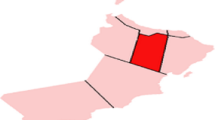Abstract
The extensive use of veterinary drugs in livestock farming increases the risk that these compounds end up in the environment when manure is used as fertilizer. This study focuses on the fate of antibiotics in liquid manure tanks before the liquid manure is spread on fields. A 180-day degradation experiment of four commonly used antibiotics erythromycin, roxithromycin, salinomycin, and tiamulin in liquid manure was performed. The resulting half-lives during manure storage were calculated as follows: 41 days for erythromycin, 130 days for roxithromycin, and 6 days for salinomycin. A first-order degradation rate was calculated for these three antibiotics. The concentration of tiamulin remained unchanged during the entire experiment. No degradation of tiamulin was detected even after 180 days.





Similar content being viewed by others
References
Agricultural board North Rhine Westphalia (2005)
Bester K, Bordin G, Rodriguez A, Schimmel H, Paulwels J, VanVyncht G (2001) How to overcome matrix effects in the analysis of pesticides in fruit by HPLC-ESI-MS-MS. Fresenius J Anal Chem 371:501–555
Christian T, Schneider RJ, Färber HA, Skutlarek D, Meyer MT, Goldbach HE (2003) Determination of antibiotics residues in manure, soil, and surface waters. Acta Hydrochim Hydrobiol 31:34–44
European Commision (2002) Proposal for a regulation of the European Parliament and of the Council on Additives for Use in Animal Nutrition. Official J C 203 E 2:1–40
European Commision (2004a) List of the authorised additives in feedingstuffs published in application of Article 9t (b) of Council Directive 70/524/EEC concerning additives in feedingstuffs. Official J C 50:1–144
European Commision (2004b) Commission Regulation (EC) No. 1463/2004 of 17 August 2004 concerning the authorisation for 10 years of the additive Sacox 120 microgranulate in feedingstuffs, belonging to the group of coccidiostats and other medicinal substances. Official J L 270:5–7
Federal Statistical Office Germany (2004) Rinder- und Schweinebestand 3. November 2004 Fachserie 3, Reihe 4.1
Gavalchin J, Katz SE (1994) The persistence of fecal-borne antibiotics in soil. J AOAC Int 77:481–485
Giger W, Alder AC, Golet EM, Kohler H-PE, McArdell CS, Molnar E, et al. (2003) Occurrence and fate of antibiotics as trace contaminants in wastewaters sewage sludge and surface waters. Chimia 57:485–491
Göbel A, McArdell CS, Suter MJ-F, Giger W (2004) Trace determination of macrolide and sulfonamide antimicrobials: A human sulfonamide metabolite and trimetoprim in wastewater using liquid chromatography coupled to electrospray tandem mass spectrometry. Anal Chem 76:4756–4764
Goodman Gilman A, Rall TW, Nies AS, Taylor P. (1990) Goodman and Gillman’s The pharmacological basis of therapeutics. Pergamon Press, New York, NY, pp 1384–1395
Haller MY, Müller SR, McArdell CS, Alder AC, Suter MJ-F (2002) Quantification of veterinary antibiotics (sulfonamides and trimethoprim) in animal manure by liquid chromatography-mass spectrometry. J Chromatogr A 952:111–120
Halling-Sørensen B, Nors Nielsen S, Lanzky PF, Ingerslev F, Holten Lützhøft HC, Jørgensen S E (1998) Occurrence, fate and effects of pharmaceutical substances in the environment—A review. Chemosphere 36:357–393
Hamscher G, Sczesny S, Höpner H, Nau H (2002) Determination of persistent tetracycline residues in soil fertilized with liquid manure by high-performance liquid chromatography with electrospray ionization tandem mass spectrometry. Anal Chem 74:1509-1518
Hirsch R, Ternes T, Haberer K, Kratz K-L (1999) Occurence of antibiotics on the aquatic environment. Scien Total Environ 225:109–118
Ingerslev F, Halling-Sørensen B (2001) Biodegradability of metronidazole, olaquindox, and tylosin and formation of tylosin degradation products in aerobic soil-manure slurries. Ecotoxicol Environ Safe 48:311–320
Kolpin DW, Furlong ET, Meyer MT, Thurman EM, Zaugg SD, Barber LB, et al. (2002) Pharmaceuticals hormones and other organic wastewater contaminants in US streams, 1999-2000: A national reconnaissance. Environ Sci Technol 36:1202–1211
Kroker R (1983) Aspekte zur Ausscheidung antimikrobiell wirksamer Substanzen nach der chemotherapeutischen Behandlung von Nutztieren. Wiss Umwelt 4:305–308
Kümmerer K (2001) Drugs in the environment: Emission of drugs, diagnostic aids and disinfectants into wastewater by hospitals in relation to other sources—A review. Chemosphere 45:957–969
Kümmerer K, (2004) Pharmaceuticals in the environment, 2nd ed. Springer, Berlin, Germany
Neu HC (1992) The crises in antibiotics resistance. Science 257:1064–1073
Pfeifer T, Spiteller M (2001) Reducing the tailing of substances adsorbing on silica surfaces by a simple modification of the Finnigan atmospheric pressure chemical ionisation source. Rapid Commun Mass Spectrom 15:2206–2207
Pfeifer T, Tuerk J, Bester K, Spiteller M (2002) Determination of selected sulfonamide antibiotics and trimethoprim in manure by electrospray and atmospheric pressure chemical ionisation tandem mass spectrometry. Rapid Commun Mass Spectrom 16:663-669
McArdell C, Molnar E, Suter MJ-F, Giger W (2003) Occurrence and fate of macrolide antibiotics in wastewater treatment plants and in the Glatt valley watershed, Switzerland. Environ Sci Technol 37:5479–5486
Schlüsener MP, Bester K, Spiteller M (2003a) Determination of antibiotics such as macrolides, ionophores and tiamulin in liquid manure by HPLC–MS/MS. Anal Bioanal Chem 375:942–947
Schlüsener MP, Spiteller M, Bester K (2003b) Determination of antibiotics from soil by pressurized liquid extraction and liquid chromatography-tandem mass spectrometry. J Chromatogr A 1003:21–28
Thiele-Bruhn S, Aust M-O (2004) Effects of pig slurry on the soprtion of sulfonamide antibiotics in soil. Arch Environ Contam Toxicol 47:31–39
Tolls J (2001) Sorption of veterinary pharmaceuticals in soil: A review. Environ Sci Technol 35:3397–3406
Vértesy L, Hril K, Fehlhaber H-W, Ziegler W (1987) Micobial decomposition of salinomycin. J Antibiotics 40:388–390
Acknowledgments
The authors are indebted to the farmer in North-Rhine-Westphalia who cooperated in the manure sampling and provided data on the application of antibiotics during conventional farm management. The HR-MS measurement of W. Karow, MS facility of the University Duisburg-Essen, is also acknowledged. This study was supported by the Ministry for Education, Science and Research of NRW, Germany.
Author information
Authors and Affiliations
Corresponding author
Rights and permissions
About this article
Cite this article
Schlüsener, M.P., von Arb, M.A. & Bester, K. Elimination of Macrolides, Tiamulin, and Salinomycin During Manure Storage. Arch Environ Contam Toxicol 51, 21–28 (2006). https://doi.org/10.1007/s00244-004-0240-8
Received:
Accepted:
Published:
Issue Date:
DOI: https://doi.org/10.1007/s00244-004-0240-8




